Varieties and classification of Italian millet
Italian millet (mogar) is the most important forage crop. It is highly nutritious and rich in vitamins. Mogar is used in the alcohol and vinegar industry. Can millet be used in food? What is culture and how can it be useful to the modern consumer? You will find detailed answers to these questions in our article.
The content of the article
What is Italian millet
Italian millet - it is an annual cultivated plant of the cereal family... It belongs to the species Italian bristle (Setaria italica). Moharicum is a cultivated variety of this plant.
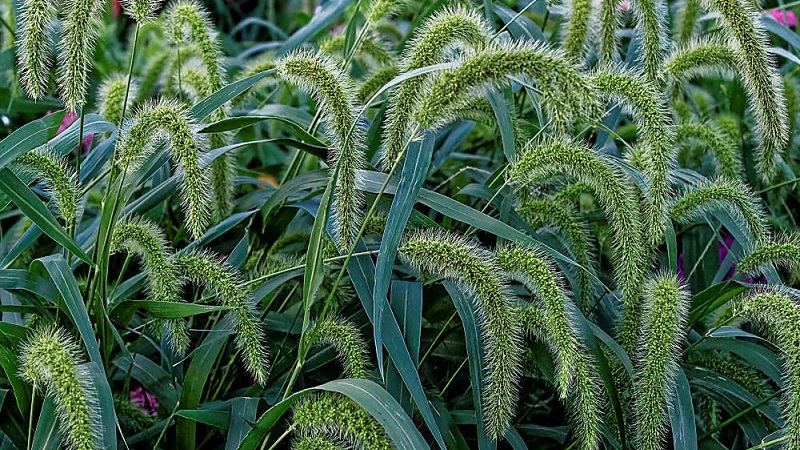
Description and characteristics of the plant Mogar (Italian bristle)
It is a dense shrub plant that forms a closed herbage. Has the following characteristics:
- fibrous root system, penetrating into the soil to a depth of 100-150 cm. Almost all roots are located in the topsoil;
- plant height 135-170 cm;
- the shape of the bush is upright;
- the stem has 6-8 internodes, pubescent, cylindrical, the number of stems in the bush is 2-7;
- leaves 45-50 cm long, foliage reaches 43-44%;
- inflorescence - spike-shaped panicle;
- spikelets are one-flowered;
- seeds are yellow, elliptical, small, weight 1000 pcs. grains 2.8-3.6 g;
- blooms from July to August.
Economic value and application
The crop is used in the food and feed industries... It is cultivated for hay, green fodder, silage and grain.
Application of Mogar:
- provides animals with green food from summer to late autumn;
- highly nutritious grain, in whole form serves as an ideal feed for birds, and in ground - for all animals for agricultural purposes;
- grain is used as a raw material for the alcohol industry;
- millet is used to make cereals, flour, vinegar.
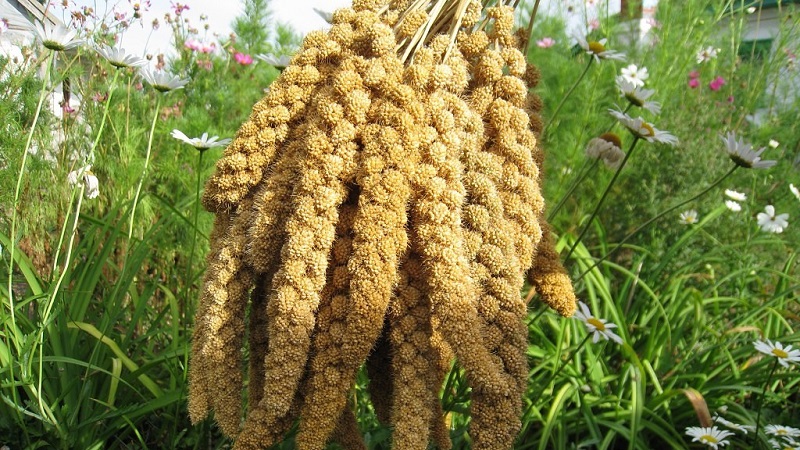
History of appearance
Mogar was cultivated as an agricultural plant in the late 17th century... Today it is found in the wild in Asian countries. As a cultivated plant, it is more often grown in countries with subtropical and temperate climates. The main purpose is feed.
Mostly Mogar is imported by India and China... There it is grown in mountainous areas at altitudes up to 2000 m, where the amount of precipitation is 500-700 mm per year.
It is interesting:
Varieties, classification and varieties of Italian millet
Scientific classification of culture:
- The kingdom is plants;
- Subkingdom - green plants;
- Department - flowering;
- Class - monocots;
- Family - cereals;
- Genus - bristle;
- View - Mogar.
Varieties of culture Mogar:
Important! All varieties except for the Kabir variety are zoned in all regions of Russia. People use millet as a dietary product. Mogar's value is great thanks to the rich vitamin and mineral complex and not only: Calorie content of Mogar: there are 342 kcal per 100 g. Mogar is rich in vitamins such as: vitamin B9 - 40 mg, vitamin B1 - 40 mg, vitamin A - 3 mg, vitamin PP - 4.6 mg. Contains macro and microelements: phosphorus - 223 mg, potassium - 211 mg, magnesium - 83 mg, sulfur - 77 mg, aluminum - 100 mg, copper - 370 mg. Important! The only contraindication to the use of Mogar is allergy and individual intolerance. Mogar is a culture that is beneficial to both animals and humans. It is given to animals as: Mogar grain is used in the food industry... Porridge is made from it. The rules for cooking porridge do not differ from traditional ones. They make both sweet and salty porridge, in milk or water. The grains are used to make flour, which has a peculiar and slightly piquant taste. The flour is used to bake baked goods and pasta. The products from Mogar taste like rye bread. Raw food lovers sprout Mogar grains and add them to salads and various vegetable dishes. In the alcohol industry, grains of Italian millet are used to make wine or beer. Mogar - drought-resistant and heat-loving culture... Seed germination begins at a temperature of + 8 ... + 10 ° C. Important! Frosts below -2 ° C damage Mogar seedlings. When grown in favorable conditions, the yield reaches: The plant prefers loose, unoccupied soil. For planting Italian millet, choose light soils with the addition of sand.... The plant will not grow in swampy or shale soils. Best predecessors for Mogar - legumes and row crops. Important! On an area protected from wind erosion by forest strips, the crop gives the maximum yield. Soil cultivation takes place in several stages: Important! When cultivating the soil, it is necessary to remove weeds, since Mogar grows slowly at the beginning of the growing season. The quality and quantity of the crop is largely determined by the condition of the seed. Seed preparation is carried out in several stages: Important! Only well-cleaned seeds with conditioned germination and exposed to air-thermal heating can be vernalized. For sowing, use well-dried and prepared seeds. Sowing: Seeding depth - 3-5 cm... Sowing is carried out in moist soil when the arable layer warms up to 10-12 ° C. Sowing dates: Important! With early sowing of seeds, seedlings appear with a delay, and the field is overgrown with weeds. The sprouts are prone to spring frosts. In the case of a delay in sowing due to drying out of the soil, the seedlings will be uneven, and the root system will be weak. Correct and timely agro-technical and chemical treatment of crops will help to achieve success in obtaining a high-quality harvest. The crops of Mogar are exposed to diseases such as: smut, striped and streaky bacteriosis, melanosis. Crop pests - bread striped flea, cicadas and thrips. Important! Chemical methods of protection are used as a last resort if agrotechnical measures did not help. After sowing, rolling is carried out... It promotes better seed-to-soil contact. When the first shoots appear, inter-row harrowing of crops is carried out to a depth of 4-5 cm in order to weed and loosen the soil. After 10-15 days, the second harrowing of crops is carried out... In the same period, fertilizing with organo-mineral fertilizers is carried out in the amount of 1-2 centners per hectare. It is also recommended to use: slurry (4-5 tons per hectare), poultry manure (4-5 centners per hectare), ash (3-5 centners per hectare) Using a combine harvester, the crop is harvested: Read also: Specialists recommend people to use italian millet when: Important! The norm of sprouted millet per day is 9-15 g of seeds. Italian millet has many beneficial properties. The elements that make up its seeds have a positive effect on human health. And when used as a forage crop, Mogar will significantly strengthen the fodder base of the economy.
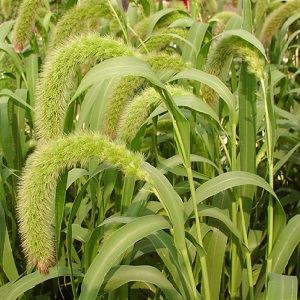 Altai 23. Originator: FGBNU FANTSA;
Altai 23. Originator: FGBNU FANTSA;Chemical composition, trace elements, calorie content of Italian millet
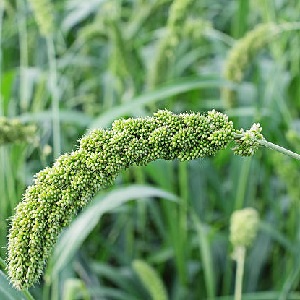 The nutritional value:
The nutritional value:
Who can be fed with Italian millet
Features of growing in the open field

Choosing a landing site
Soil preparation
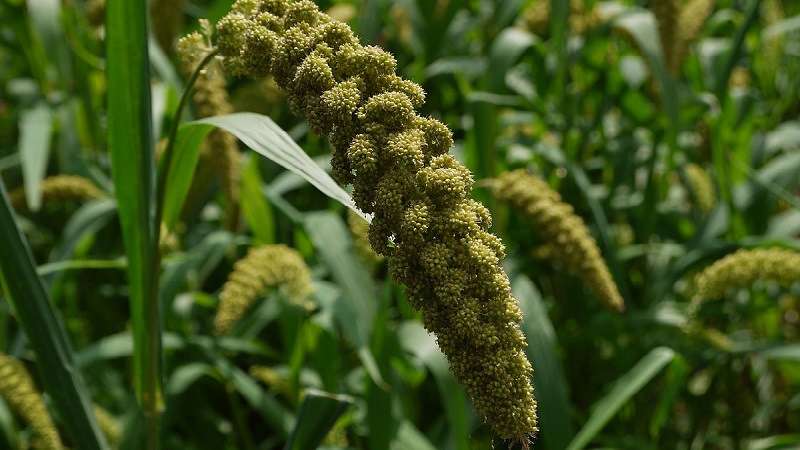
Seed preparation
Landing scheme and technology

Treatment against diseases and pests
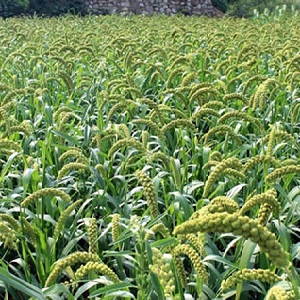 For chemical treatment of crops from diseases and pests apply such schemes:
For chemical treatment of crops from diseases and pests apply such schemes:
Care features
Tips and tricks for growing and using Italian millet
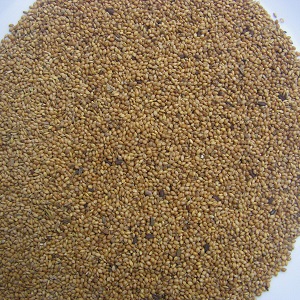 PWhen growing Italian millet, it is recommended:
PWhen growing Italian millet, it is recommended:
Conclusion